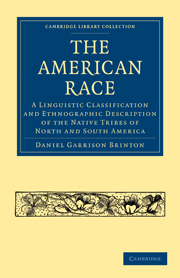 The American Race
The American Race III - THE CENTRAL GROUP
Published online by Cambridge University Press: 29 August 2010
Summary
THE UTO-AZTECAN TRIBES
OF all the stocks on the North American Continent, that which I call the Uto-Aztecan merits the closest study, on account of its wide extension and the high development of some., of its members. Tribes speaking its dialects were found from the Isthmus of Panama to the banks of the Columbia river, and from the coast of the Pacific to the Gulf of Mexico. The relationship of these numerous bands is unquestionable, although many of them have freely adopted words from other stocks. This, however, will not surprise us if we recall that most of the Aryac languages of the old world owe about one third of their radicals to non-Aryac sources.
The principal members of this stock are the Utes, Shoshonees and Comanches in the north, various tribes in Sonora, Chihuahua, Sinaloa and Durango in the center, and the Nahuas or Aztecs in the south. It is not to be understood that the one of these derived its idioms from the other, but rather that at some remote epoch all three were offshoots from some one ancestral stem. This was at a period before the grammatical forms of the tongue had reached full development, and probably when it was in a stage of isolation, with tendencies to suffix agglutination and incorporation. Since then the stages of growth which the several dialects have reached have been various. The one which far outstripped all others was the Nahuatl, which arrived at clear and harmonious sounds, fixed forms, and even some recognizable traces of inflection, though always retaining its incorporative character.
- Type
- Chapter
- Information
- The American RaceA Linguistic Classification and Ethnographic Description of the Native Tribes of North and South America, pp. 118 - 164Publisher: Cambridge University PressPrint publication year: 2009First published in: 1891
